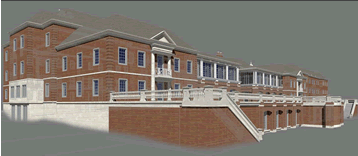
Jonathan Kirk

Structural Option
School of Engineering and Applied Sciences Building
Miami University, Oxford, Ohio
| Home |
| Student Biography |
| Building Statistics |
| Thesis Abstract |
| Technical Assignments |
| Thesis Research |
| Thesis Proposal |
| Presentation |
| Final Report |
| Reflection |
| Senior Thesis e-Studio |
User Note: While great efforts have been taken to provide accurate and complete information on the pages of CPEP, please be aware that the information contained herewith is considered a work‐in‐progress for this thesis project. Modifications and changes related to the original building designs and construction methodologies for this senior thesis project are solely the interpretation of Jonathan Kirk. Changes and discrepancies in no way imply that the original design contained errors or was flawed. Differing assumptions, code references, requirements, and methodologies have been incorporated into this thesis project; therefore, investigation results may vary from the original design. |
Thesis Proposal |
|
|
Thesis Proposal Breadths (pdf) Thesis Proposal (pdf) - Revised 1/17/08 Thesis Proposal Breadths (pdf) - Revised 1/17/08 This proposal will outline the structural depth and two breadth topics to be investigated in the spring semester. The School of Engineering and Applied Science building will be redesigned with a precast hollowcore floor plank supported by a steel frame floor system. The building enclosure will be redesigned with precast concrete architectural insulated wall panels. Cost and schedule comparisons of the proposed changes wil be performed to analyze the pros and cons each system offers. Click on the above links for copies of both the full proposal or simply the executive summary with breadth options. Breadth Options Precast architectural wall panels offer a number of advantages over the current face brick on steel stud wall system. Construction time will be decreased significantly, offering the benefit of decreased labor cost and faster enclosure of the building. Other trades will be able to begin their work on the project much sooner, and hence allow faster completion of the building. The overall look of the façade will not need to be altered significantly, since wall panels with a “thin brick” face are easily produced in a precast plant. These insulated wall panels are sometimes referred to as sandwich panels, since they are essentially made with a layer of rigid insulation sandwiched between two concrete wythes. Wall panel connection details will be designed to ensure proper performance of the system for the climate of the site. The proposed change of envelope may have a significant impact on the building’s mechanical heating and cooling loads, as well as durability issues which will need to be compared to the existing system and evaluated as to which system offers the best performance and economy. A construction management breadth is a necessity for this thesis, since the main goal of switching to precast building element is for a faster construction schedule and increased economy. An in depth study of the new construction timeline and erection sequence will be performed to analyze the impact of the proposed changes using Microsoft Office Project by creating a schedule using both the existing and proposed designs. Also, detailed cost estimation takeoffs will need to be calculated to evaluate the cost savings or increase of the new systems. Material and labor costs will be found using the latest RS Means Construction Cost Data available. |
|